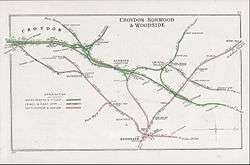West Norwood railway station
West Norwood railway station is in the London Borough of Lambeth in West Norwood, south London. It is 7 miles 2 chains (11.3 km) measured from London Victoria. The station, and all trains serving it, are operated by Southern, and it lies in Travelcard Zone 3. Services from platform 1 go to London Victoria and London Bridge via Tulse Hill. Services from platform 2 operate to more varied destinations, including West Croydon and London Bridge via Crystal Palace.
| West Norwood | |
|---|---|
West Norwood station building | |
 West Norwood Location of West Norwood in Greater London | |
| Location | West Norwood |
| Local authority | London Borough of Lambeth |
| Managed by | Southern |
| Station code | WNW |
| DfT category | D |
| Number of platforms | 2 |
| Accessible | Yes[1] |
| Fare zone | 3 |
| National Rail annual entry and exit | |
| 2014–15 | |
| 2015–16 | |
| 2016–17 | |
| 2017–18 | |
| – interchange | |
| 2018–19 | |
| – interchange | |
| Key dates | |
| 1 December 1856 | Opened |
| 1 January 1886 | Renamed |
| Other information | |
| External links | |
| WGS84 | 51.4318°N 0.1035°W |
It is located in West Norwood above Norwood High Street, and has its main entrance on the A215 road, which here is called Knights Hill. The station saw some modernisation in summer 2009, with ticket gates installed and the entrance to the eastbound platform refurbished. From spring 2010 the gates have been staffed from first to last train.
History
The station was opened as Lower Norwood on 1 December 1856, as part of the West End of London and Crystal Palace Railway. It was renamed on 1 January 1886 by the London, Brighton and South Coast Railway (LBSCR), owing to the objections of an influx of new residents who objected to the "lower" prefix; they preferred the locale to be described instead as West Norwood.[3]
Electric train services were introduced on 12 May 1911 between Victoria, Balham and Crystal Palace. They used an AC overhead wire system developed by the LBSCR as part of their Elevated Electric scheme. This system was replaced by the current third rail DC system on 3 March 1929.
The original station buildings were demolished in 1969, and replaced with prefabricated CLASP buildings.
Service
The typical off-peak service frequency is:
- 4tph (trains per hour) to London Victoria
- 2tph to London Bridge via Tulse Hill
- 2tph to London Bridge via Crystal Palace and Forest Hill
- 2tph to Beckenham Junction via Crystal Palace
- 2tph to Sutton via West Croydon
| Preceding station | Following station | |||
|---|---|---|---|---|
| Streatham Hill | Southern London Victoria to London Bridge (via Crystal Palace) London Victoria to Sutton (via Crystal Palace) London Bridge to Beckenham Junction (via Crystal Palace) (Mondays-Saturdays only) |
Gipsy Hill | ||
| Tulse Hill | Southern Inner South London Line |
|||
Gallery
| Wikimedia Commons has media related to West Norwood railway station. |
 A 1908 Railway Clearing House map of lines around West Norwood railway station.
A 1908 Railway Clearing House map of lines around West Norwood railway station. A 1908 Railway Clearing House map of lines around the West Norwood railway station, as well as surrounding lines.
A 1908 Railway Clearing House map of lines around the West Norwood railway station, as well as surrounding lines.
References
- "London and South East" (PDF). National Rail. September 2006. Archived from the original (PDF) on 6 March 2009.
- "Station usage estimates". Rail statistics. Office of Rail Regulation. Please note: Some methodology may vary year on year.
- Mitchell, Vic; Smith, Keith (1994). Clapham Jn to Beckenham Jn. Middleton Press. ISBN 1-873793-36-7.
External links
- Train times and station information for West Norwood railway station from National Rail